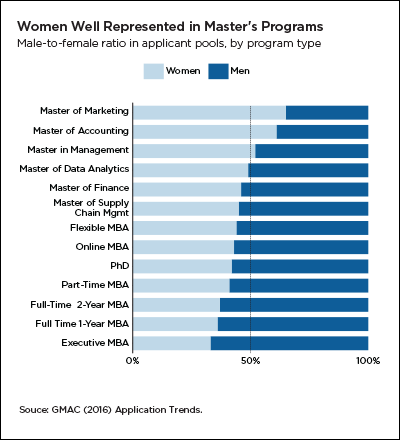You'll find them a-plenty in non-MBA master's programs, especially the 'hot' new quant programs; less so in full-time MBA classrooms.

The remarkable aspect to this year’s trends in the number of women applying to graduate business school is how predictable the data has become, at least based on year-on-year findings from GMAC’s
Application Trends Survey, which closed out in mid-July with a record number of 872 programs participating worldwide. Women are holding their own in the incoming 2016–2017 classes at graduate business programs around the globe—overall they represent 44 percent of the total applicant pool compared with 56 percent for men. These stats are the same as those reported in the 2015 survey findings, which showed an identical gender ratio.
Participation Rate for Women in MBA Programs Relatively Unchanged Over Five Years
The predictability factor comes into full play when the annual trends are broken down by program types. The results for MBA programs in the 2016 survey (shown in the figure below) closely resemble the percentages reported over the last five years.
- From 2012 through 2016, the proportion of women in the applicant pool for full-time two-year MBA programs has averaged 38 percent—in 2016 it stands at 37 percent.
- The proportion of women in full-time one-year MBA programs is similar—averaging 37 percent over the five-year period compared with 36 percent this year.
Only once in the last five years (based on Applications Trends Survey data for those years ) has the share of women in full-time MBA programs reached 40 percent, and that was just last year—women accounted for 40 percent of the applicant volume for full-time two-year MBA programs.
The gender ratio for executive MBA programs averages out to 33 percent women versus 67 percent men over the past five years, which also is the current proportion for 2016. The executive MBA is a bit of an outlier compared with other professional MBA programs, which historically attract a higher proportion of female applicants than the full-time MBA offerings.
- Over the past five years, women’s share of the applicant pool for professional MBA programs averages 43 percent for flexible MBA, 41 percent for part-time MBA, and 41 percent for online MBA programs.
- These proportions hold fairly steady in 2016, with 44 percent for flexible MBAs, 43 percent for online MBAs, and 41 percent for part-time MBAs.
Interestingly, more than half of full-time MBA programs (54% two-year and 52% one-year) report receiving more applications from women in 2016 than they did last year. And more than 4 in 10 flexible, part-time, and online MBA programs did as well. Nevertheless, the status quo in the gender makeup of the applicant pool for MBA programs persists, despite the efforts of many of these programs to attract and recruit more female applicants.
Status of Women in Master’s Programs Remains Strong; Shows Robust Growth in New Fields
Non-MBA, or business master’s programs, are where the GME landscape gets more interesting. In 2016, women continue their historic overrepresentation (compared with men) in the applicant pools for some business master’s programs (e.g., marketing, 65% women; accounting, 61%; and management, 52%), and are keeping pace with men in other traditional programs like finance (54% men vs. 46% women). When averaged over the five-year period from 2012 to 2016, these gender proportions are also relatively stable.
But in addition to maintaining a strong presence in traditional master’s programs, women are making inroads to some of the “hot” new quantitative programs that are on the rise in the GME space. Master in Data Analytics and Master in Supply Chain Management programs are two relatively new (or increasingly more popular) business master’s programs that drew large shares of female applicants this year. Forty-five percent of applicants to Supply Chain Management programs this year were female versus 51 percent male. Data Analytics, a program that has only been analyzed in GMAC’s survey data since last year, has achieved near gender parity with a 51 percent to 49 percent split between men and women, respectively. What’s more, 93 percent of Data Analytics programs that submitted application trends data comparing volumes for 2016 with last year report increased application volume from women.
These master’s programs and others represent some of the greatest growth areas in the GME space, creating more options for prospective students, women in particular. Survey responses in 2016 show a notable expansion of programs such as Master in Data Analytics programs (36% are new in 2017), Master in Supply Chain Management (19% are new in 2017), and Master of Marketing (16% are new in 2017).

No Mystery in Women Gravitating to Non-MBA Programs
It’s no mystery—one could say it’s predictable—that year after year women are more heavily represented in the applicant pools for business master’s programs than in MBA programs. These are the programs they consider and prefer more so than men. A quick look at the results of GMAC’s mba.com Prospective Students Survey from 2015 (analyzed from a sample of more than 10,000 mba.com registrants) shows that, when contemplating GME, the share of men considering MBA programs outnumbers women (78% men vs. 68% women) and the share of women considering business master’s programs exceeds men (54% women vs. 43% men). When designating their most preferred type of business program, the results are similar—women are more likely than men to prefer non-MBA master’s programs (and also prefer part-time, online, and flexible MBA programs slightly more than men). More men than women express a distinct preference for full-time MBA and executive MBA programs.
This is not to suggest that all or even a portion of these prospective students surveyed in 2015 are represented in the application trends that business schools reported this year, but it may illuminate where trends are heading. Many factors influence women’s decisions about whether or not to apply to graduate business school—cost, personal life situation, market conditions, cost/benefit analysis of continuing to work versus dropping out of the workforce to attend school full-time, among others. Perhaps wanting to complete a program in the shortest amount of time in order to resume a career or before starting a family may make a one-year master’s program or a flexible, part-time, online, or one-year MBA program more attractive. The list is infinite and doesn’t follow the same playbook as men.
For schools wanting to maintain a strong pipeline of female candidates entering their programs, some questions to ponder:
- Have MBA programs, notably full-time and executive programs, possibly reached a set point in the share of female applicants they can reasonably expect to attract year on year?
- How are external economic, social, and market conditions beyond the control of business schools dictating women’s choices in graduate education in ways that may differ from men?
- Are the growing number of master’s programs outcompeting MBA programs in their appeal to female candidates and in meeting their educational needs?
- What can MBA programs do to improve their value proposition for female prospective students who might be vacillating between choosing an MBA versus a master’s program?
For more information on application volume trends in graduate management education, as well as data related to targeted candidate outreach, download the 2016 Application Trends Survey Report, available now at gmac.com/applicationtrends. For more insight into the motivations of prospective students considering graduate management education, download the 2016 mba.com Prospective Students Survey Report, available at gmac.com/prospectivestudents.